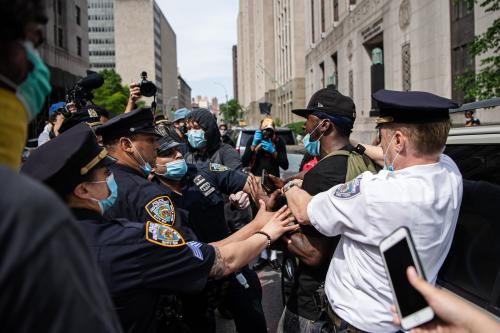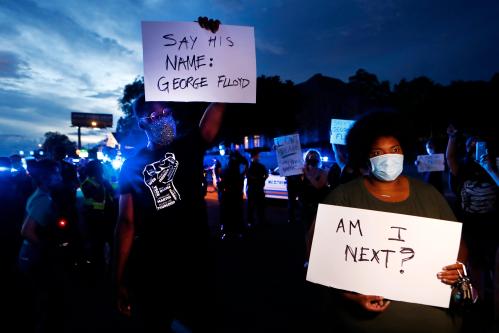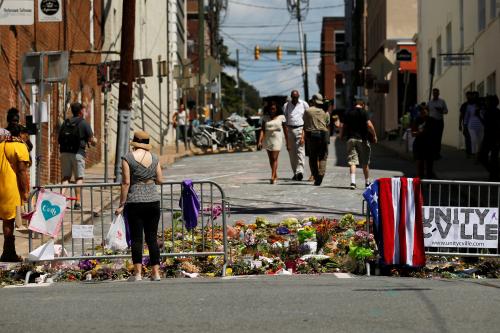While we have terms for others who have experienced trauma, in over 400 years of racism, we do not yet have a term for Black and Brown people who experience racial terrorism. This is a devastating and telling omission in our lexicon because it conveys how a majority-white society in the United States has refused to acknowledge the ongoing experience of living day in and day out in a society that was founded on the reality of working African slaves, and later African Americans, until their tendons literally snapped from their bones.
When, for nearly nine minutes, Officer Derek Chauvin pressed his knee into George Floyd’s neck on May 25, 2020, not releasing the pressure when Mr. Floyd said he could not breathe, not releasing it when bystanders cried out, nor releasing it for almost three minutes after Mr. Floyd was unresponsive, the inhumane treatment and brutality upon which this nation was founded were exposed in all of their ugliness for everyone, worldwide to see.
In this moment, as we reflect on just how deranged, sadistic, and yet commonplace Mr. Floyd’s murder was, mayors and governors are under pressure to respond urgently to endemic racism. Because that hasn’t been done effectively in the 400-plus years since slaves first arrived on our shores, mayors and governors are going to have to create their own blueprints.
So, mayors and governors, here is what you must do now to create sustained racism-free equity.
Acknowledge Racism. First, establish a three-month-long formal public forum, similar in structure to South Africa’s Truth and Reconciliation Commission where Black and Brown community members are invited to provide statements about their experiences—both in every day life and otherwise—and where white community members listen, acknowledge, and respond to those experiences. This forum and the acknowledgement that emerges from it should be used to develop a common understanding of what racism is and what it means to establish an equitable community.
Establish Equity Goals. Second, simultaneously, establish an Equity Task Force that has significant poor Black and Brown representation. The purpose of the Equity Task Force is to work with a sense of urgency to develop a detailed and funded equity plan that resolves key disparities within a two- to four-year timeframe. Those disparities should include education, jobs and income, policing, and health/well-being, but should also include other goals as well.
The Equity Task Force should identify specific, time-bound metrics for each of the key disparity goals and should be guided, as appropriate, by existing and validated frameworks such as the social determinants of health. For instance, if there are few parks in Black and Brown neighborhoods, but many in white neighborhoods, the Equity Task Force should aim to have similar acreage of highly accessible parks within Black and Brown neighborhoods within a two- to four-year time frame. If Black and Brown students are more likely to go to schools that do not have digital technology or are more likely to live in homes without broadband access, the Equity Task Force should set a goal of eliminating those disparities within two years.
In addition, the Equity Task Force should spend considerable time reflecting on how racism has created policies, attitudes, and cultural conventions that regulate physical and cultural space. Redlining is perhaps the most obvious and well-known example of efforts to regulate physical space. Signs from the late 20th century that stated “No Negroes and No dogs,” are also examples. So are many loitering laws and ways in which the built environment has been constructed to regulate egress from Black and Brown neighborhoods. The task force should identify those ways in which physical and cultural segregation has become the norm and create concrete, time-bound goals to eliminate policies and conventions that regulate the physical and cultural spaces that Black and Brown people occupy.
Resource Equity. Third, mayors and governors should be prepared to attach funding to all Equity Task Force initiatives. They should think strategically about how any new federal COVID-19 stimulus money can be used now to address racial disparities. They should be using existing federal waivers to federal programs to create equitable health care, education, and broadband access. And they should be inviting philanthropic and corporate interests to share the fiscal responsibility for equity goals. Mayors and governors should take pioneering steps and develop and market equity bonds that can be bought on the municipal lending market. They should also be working to eliminate the bureaucratic challenges associated with pooling money from different municipal or state departmental budgets so that monies can be merged to address problems quickly and efficiently.
Innovate. Fourth, mayors and governors should also identify areas that are ripe for innovation. For instance, we now know a lot more about juvenile brain development than we did when the juvenile justice system was being developed. That system is based upon outdated and inaccurate understandings of how young people develop and mature. And because the juvenile justice system disproportionately targets young people of color, it should be a priority focus of mayors and governors. Don’t be afraid to ask: Do we need a juvenile justice system at all? And toward what equity goal could we redirect current juvenile justice funding if we eliminated juvenile justice?
Another area of innovation, which has now been tested nationwide during the current pandemic, is providing residents with a stipend. Mayors and governors should gather data that crystallizes the racial wealth gap in their jurisdictions and should experiment with a combination of stipends, better access to credit, and more educational opportunities for Black and Brown adults to address that wealth gap.
Measure Equity Impacts. Fifth, all programs and policies, whether or not they are formally under the aegis of the Equity Task Force, should be evaluated from an equity perspective. San Francisco’s Financial Justice Project is an exemplar in this area.
Finally, the video that captured Mr. Floyd’s last, tortured moments starkly illustrates that every mayor and governor should be asking themselves today: What would I do differently, if my loved one were to draw his last breath under the knee of a murderer while being held down by other murderers? What would I do differently to ensure that the life of my loved one was welcome and valued?
Be the exemplar. Move with urgency. Understand that what Black and Brown people saw in that video was that Mr. Floyd died without an acknowledgment of his humanity. The U.S. aspires to be better than that. In this moment, with antagonism spewing from the White House, mayors and governors have to lead the way.







Commentary
Mayors and governors: This is how you tackle racism
June 2, 2020